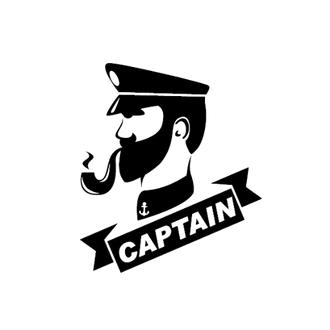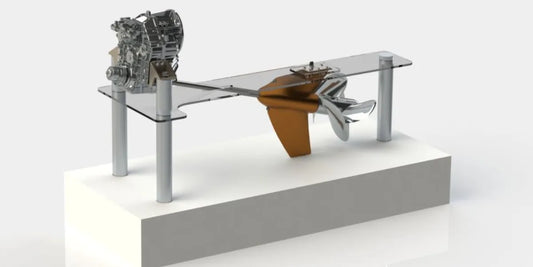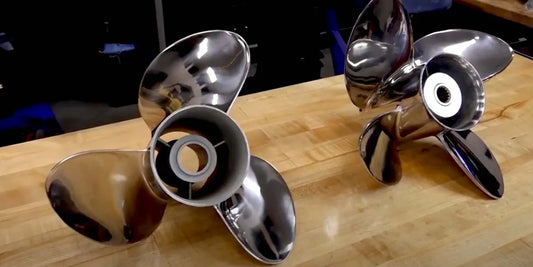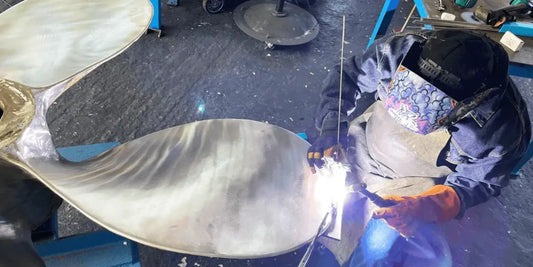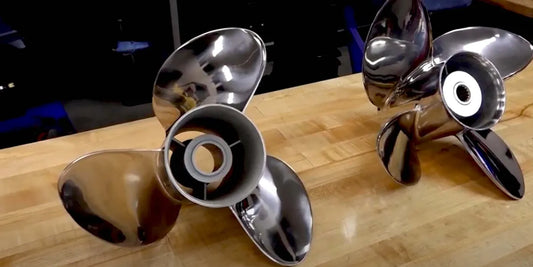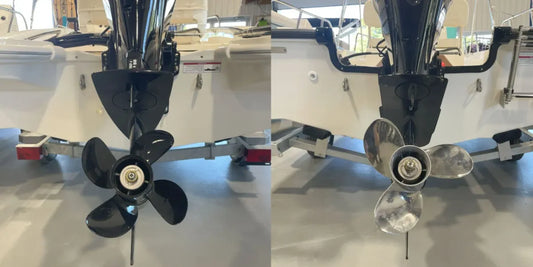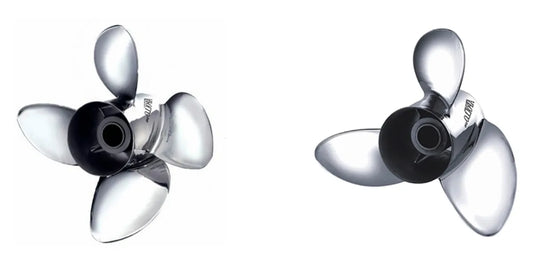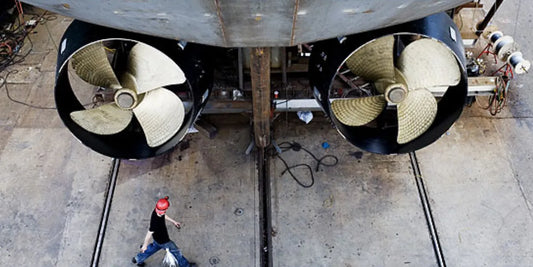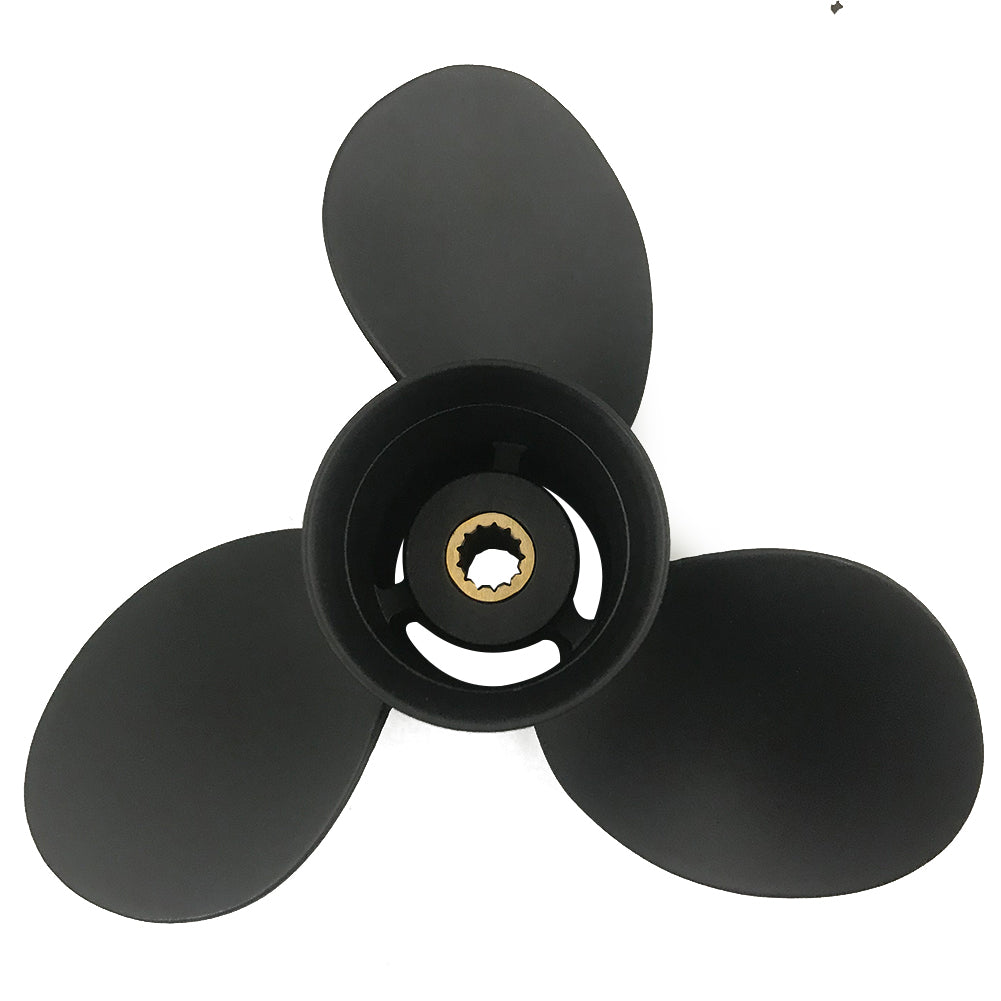Selecting the proper propeller remains a crucial decision that can significantly improve a boat's performance in terms of efficiency, speed, and handling. One of the prevalent subjects has typically been the comparison of 4-blade versus 3-blade propellers. Which one comes with a better cruising speed? Which one is better in terms of fuel efficiency or smooth handling in challenging conditions? In this guide, we delve into the nitty-gritty details, examining the technical and operational discrepancies between the two types of propellers and dissecting the actual science behind their design and function. So, whether you are a professional or a hobbyist interested in enhancing the performance of the craft you cherish, this article will serve you well in helping you choose what best fits your needs. Let's dive into the deep end of blade count and figure out which propeller will work for that boat of yours.
Understanding Propeller Basics

What is a Propeller?
Converting rotary motion into thrust, a propeller propels a vessel through a fluid medium, such as water or air. A propeller is made of several blades, or airfoils or hydrofoils, arranged around a central hub. While rotating, the blades are subjected to force by the fluid and act to create a pressure difference. The pressure at one region pushes against the low pressure formed at the opposite side, providing the necessary forward or reverse thrust for the vessel. Propeller systems are key elements in marine engineering and are usually made out of stainless steel or aluminum alloy to withstand stresses and resist corrosion. The exact design of a propeller, which includes the number of blades, pitch, and diameter, actually determines the degree of efficiency, speed, fuel consumption, and others. In other words, it is a crucial design consideration for optimizing the vessel's performance.
Types of Propellers: 3 Blade vs 4 Blade
While the choice between a 3-Blade and a 4-Blade propeller creates an entirely different ship performance, each has specific advantages to suit an operational requirement.
3-Blade Propellers: 3-Blade propellers are considered among the most efficient and fastest due to their reduced hydrodynamic drag on the blades, which results in fewer bars moving through the water. These propellers provide higher top-end speeds and are therefore suitable for applications where the highest velocity is required. The 3-blade design is lightweight and has lower production costs, thus reducing maintenance, making it a widespread choice among vessels of a performance nature, such as speedboats and light recreational watercraft. At low speeds, however, there is slightly less thrust and stability than with 4-blade types.
4-Blade Propellers:They produce more thrust and smoothly accelerate the boat with low-speed handling characteristics, which apply to heavy loads, towing applications, and running in adverse sea conditions. The extra blade provides strength and reduces vibration, resulting in improved fuel economy at cruising speeds and in calm conditions. Lying in opposition to the issue of top speed being sacrificed due to high drag, these props end up in fishing boats, utility vessels, and cruising yachts, offering the best control and reliability.
Performance Comparison: When selecting between 3-blade and 4-blade propellers, there are trade-offs to consider, including the vessel's purpose, loading capacity, and desired speed. For example, in most applications, a 3-blade propeller could provide a top speed gain from 5 to 10% over a 4-blade propeller. In contrast, thrust from a 4-blade propeller might be up to 30% higher in heavy load situations. Ultimately, the right choice and tuning of the propellers must be made to achieve the best performance, taking into account engine power, hull design, and operating conditions.
How Propeller Design Affects Performance
In the very design of the propeller lies the hydrodynamic efficiency of the vessel and, accordingly, how it fares. The important features include the blade count, the pitch, the diameter, and the material from which it is manufactured. The pitch of the blade-the distance it will theoretically cover in a forward direction for each rotation- is one parameter that controls the generation of thrust and speed potential. A higher pitch of a propeller allows for significant forward movement, but at the same time, it requires more engine power and is thus intended for high-speed purposes. Conversely, heavy loads and low-speed maneuverability call for low-pitch types.
Diameter also affects the thrust, with larger diameters producing more thrust at lower RPMs when towing or carrying loads. Furthermore, the choice of material—commonly aluminum, stainless steel, or composite—impacts durability, weight, and cost, with stainless steel being preferred for its high tensile strength and efficiency in high-stress situations.
Using advanced CAD and CFD programs, the pristine modeling and optimization of propeller geometries has been realized. Minimizing cavitation and providing better flow uniformity, these CAD and CFD tools enable design modifications for each vessel according to its specific requirements, while maintaining good fuel efficiency and reducing vibration. This is yet another area where industrial demands have begun to emphasize sustainability and the precision of performance.
Efficiency Comparison: 3 Blade vs 4 Blade Prop

Fuel Efficiency and Performance
The number of blades can dramatically affect the fuel economy and performance of a propeller. Typically, the 3-blade propeller has less drag, allowing for a greater top speed and improved gas mileage, which is particularly beneficial in the higher RPM range. Consequently, it is suitable for lighter boats or situations where speed is a priority. The 4-blade propeller, on the other hand, offers more thrust and is thus more stable; it is generally employed when handling and load-carrying capacity need to be improved, such as in heavier vessels or rough water conditions.
Recent material and precision technology developments have had a significant impact on refining the aero- and hydrodynamic performance of these propellers. As if this were not enough, propulsion efficiency was further increased through the use of available blade designs with progressive pitch and optimized tactile texture. While the triple-blade setup is somewhat preferred for fuel economy under lower resistance drag conditions, a four-blade configuration tends to have better slip reduction and fairly steady performance when heavy loads or high demands are experienced. This distinction demonstrates the need for consideration on a case-by-case basis for propeller selection in view of the vessel's purpose and operating environment.
Acceleration and speed analysis
The relationship that exists between acceleration and speed describes a key aspect of vessel performance optimization. Acceleration measures the changes in speed over a period, and many factors impinge upon its efficiency: design of the propeller, engine power, and hull resistance. A propeller with three blades may promote faster acceleration, as it provides less drag and lower rotational inertia, which are particularly beneficial when dealing with light vessels or high-speed applications. On the other hand, a 4-blade propeller ranks higher in blade area and, consequently, in thrust development, allowing for a fairly steady acceleration of heavy loads.
Speed, mainly measured at maximum or cruising levels, depends on the thrust being balanced with hydrodynamic resistance. Modern CFD advancements permit the exact modeling of these parameters and the design of propellers suitable for the speed range of ships. Besides speed, blade pitch, diameter, and material composition are factors most responsible for efficient high-speed performance with minimum cavitation, which inhibits propulsion through the formation of vapor bubbles.
Acceleration and speed cannot be analyzed in isolation without agonizing over performance data in various conditions such as load displacement, sea state, and engine RPM. Therefore, vessel operators must ensure that propulsion is well-engineered to match the method of operation, providing good acceleration and speed efficiency.
Best Situations For Use
The efficiency and performance of propulsion systems are highly dependent on the given operational scenarios. For example, in the case of high-speed vessels such as patrol boats or ferries, propulsion systems should enable rapid acceleration and maintain smooth speed in calm sea states with average load conditions. In contrast, cargo ships or tankers operate under varying loads and challenging sea conditions, requiring systems that optimize torque and fuel economy to ensure steady performance over long-distance routes.
Operational testing yields data that indicate the matter: in high sea states, of course, the risk of cavitation is heavily increased, thereby warranting modern blade shapes with anti-cavitation features so that thrust integrity can be maintained. Engine RPM calibration, on the other hand, depends on the vessel's load displacement to ensure maximum efficiency of output while prolonging the system's life and maintaining environmental compliance. These emergent cases emphasize the need for situational alignment of propulsion configurations with maritime settings, supported by engineering innovations and system-wide calibration.
Advantages of 4 Blade Propellers

More Thrust, More Control
Four-blade propellers are designed to maximize thrust and provide better control of the vessel, particularly when it is heavier or more loaded. Since four blades spread force, they minimize slippage and provide a better grip in the water, especially at low speeds or during maneuvers. Such propellers greatly diminish vibrations: the extra blade reduces oscillations induced by engine torque, providing a very smooth operation.
Tests and field data justify the superiority of four-blade systems. For vessels with appreciable load displacement, such as passenger ferries or trawlers, unlawful disadvantages in thrust acceleration disappear, for they have several improvements in acceleration and handling stability. Contrary to the idea that larger blade areas might be a problem operationally, under severe conditions such as strong currents and intermittent sea states, the larger blade area lends creditability to operational reliability. Thus, in conjunction with the best materials and manufacturing, these four-blade designs give the best performance without fuel penalties, which is the critical concern in new-generation ocean-going activities."
Noise Reduction Advantages
More blades and smoother thrust distribution reduce underwater noise, which can be of concern for both commercial and environmental reasons. The additional blade provides a more uniform thrust distribution, as well as reduced cavitation, which is the formation of bubbles due to pressure changes. Cavitation significantly contributes to propeller noise and vibration, and reducing it provides discretion in naval applications, thereby minimizing disruption to the marine environment. Investigations show that, depending on the propeller design and the use of coatings and precision engineering, noise reduction of approximately 10 decibels is achievable. This substantial reduction aids in conforming to stricter standards of underwater noise pollution, making the maritime industry more sustainable.
Durability and Maintenance Considerations
In present-day settings, a propeller system is constructed with durability and ease of maintenance as its primary concerns, leveraging the advancements in materials science and engineering. High-performing propellers typically consist of corrosion-resistant alloys, such as nickel-aluminum bronze, which provide resistance to the elements and maintain structural integrity. Also, aluminum-silicon platings, advanced ceramic coatings, and others would further increase the resistance to biofouling and erosion so that they can survive for extended periods in severe conditions.
Maintenance protocols emphasize predictive and condition-based monitoring, with the goal of maximizing production. NDT, vibration analysis, and real-time monitoring sensors can enable pinpoint diagnostics and locate areas where wear or potential failure may occur; in other words, they facilitate the determination of whether equipment is likely to break down. These strategies are implemented to reduce unplanned downtime and to optimize maintenance scheduling, reducing lifecycle costs and ensuring reliability in challenging maritime environments.
Advantages of 3 Blade Propellers

Lightweight and Cost-Effective Options
Three-blade propellers are widely utilized because they strike a good balance between performance, price, and structural efficiency. Lighter by nature than the four- or five-blade kind, they not only reduce the rotational inertia, which in turn supports faster acceleration and better fuel efficiencies of the vessels, but also directly contribute to their lower cost in production, thereby making them an economically feasible proposition for a wide array of maritime applications. With advanced manufacturing techniques such as precision casting and CNC machining, there has been a definite enhancement in the aerodynamic efficiency of these propellers. High-strength, heat-treated alloys or composite materials are typically employed, ensuring durability while maintaining sufficient lightness throughout the design. Numerous studies have proven that excellent thrust-to-weight ratios were achieved with these, and therefore, such propellers remained popular among both commercial and recreational spheres. Their streamlined structure reduces drag, allowing for smooth and quiet operation without compromising performance or reliability.
Performance at the Higher Speed
When an increase in speed occurs, modern propeller efficiency tends to be influenced by the aerodynamic shape, material, and accuracy of manufacturing techniques. The utilization of advanced computational fluid dynamics (CFD) simulations is a step toward blade shape optimization, focusing on minimizing energy losses and mitigating cavitation effects. This optimization is fundamental because cavitation is the formation of vapor bubbles that collapse on the blade surface, resulting in efficiency losses and material erosion. Cavitation effects, after being solved through blade profile improvements and surface finishing techniques, do not limit propeller performance in difficult situations.
The use of advanced materials, such as carbon-fiber composites and titanium alloys, significantly enhances high-speed structural integrity. These materials offer a superior combination of strength-to-weight ratio and resistance to mechanical stresses resulting from abrupt acceleration. Test data reveal that propellers made from these materials improve various performance criteria, such as stable thrust delivery and reduced vibratory impacts, across different speed ranges. This reliability is particularly coveted in high-tech maritime and aeronautical applications, where sustaining operations at high speeds is critical to achieving the objective or commercial viability.
Applications For 3-Bladed Props
In terms of application, three-bladed propellers are the most ubiquitous types of propellers due to their balance of efficiency, power, and durability. These propellers are suitable for applications that require reasonably sustained thrust with reduced vibration. For instance, in medium-sized cargo and coastal patrol boats, there is an excellent propagation efficiency from three-bladed props, particularly at intermediate speeds that do not allow the model to vibrate. The same design also benefits aeronautical applications, such as small aircraft and drones, by optimizing drag reduction and thrust stability for smooth maneuverability and improved fuel efficiency.
A statistical performance study reveals that three-blade propellers achieve a higher thrust coefficient with relatively lower noise levels. Yet, owing to their robust structure, three-blade props can be utilized under highly adverse working conditions, such as high-altitude flights and water bodies with strong currents. Further advancements in computational fluid dynamics (CFD) have enhanced propeller design, optimizing flow through the propeller and reducing cavitation in marine environments, thereby ensuring a higher operational lifetime and reduced maintenance.
Choosing the Right Propeller for Your Boat

Factors to Be Considered When Selecting a Prop
Material Composition: The material composition of each propeller significantly impacts its durability, efficiency, and corrosion resistance. Aluminum, stainless steel, and bronze are common materials suitable for diverse operational environments. Stainless steel may be the best option, offering both strength and corrosion resistance in saltwater. Aluminum, on the other hand, may be a cheaper route, but it is only moderately durable in freshwater.
Propeller Diameter and Pitch: Diameter and pitch determine the propulsion and speed of the boat. A larger diameter propeller means the thrust is greater, which is particularly beneficial for heavy vessels that require more thrust. Pitch means a higher speed and renders demand from the engine. The two parameters must coincide to ensure maximum performance without engine overload.
Blade Count and Design: The number of blades primarily determines hydrodynamic efficiency, while additional parameters also influence vibration considerations. Three-blade propellers are generally versatile and are widely found on various types of boats, owing to the balance between speed and smooth operation. More blades, such as four or five, mean more thrust and less vibration, making them suitable for heavy work or high-speed cruising.
Engine Power and RPM Compatibility: Ensure that the propeller you select is compatible with the horsepower level and gross RPM range of your engine to achieve optimal performance. If it is operated outside of this range, it may put undue strain on the engine, reduce fuel efficiency, or lead to mechanical failures over time.
Usage and Environmental Conditions: The environment of usage-{from calm waters of freshwater lakes-to dangerous choppy waters of coastal areas, or high-altitude} dictates propeller selection. Special props may have cupping for coarse waters or corrosion-resistant coatings for extended use in saltwater.
Ventilation and Cavitation Considerations: Effective propeller designs minimize the occurrence of ventilation or air entering the propeller area, as well as cavitation, a process in which pressure changes lead to the formation of vapor cavities. Advanced engineering and proper sizing will generally preclude these problems, ensuring performance and longevity under all operational conditions.
A boat owner, when considering all these factors, will have a better chance of selecting a propeller that meets the specifications of their vessel and performs well under its operational requirements, allowing it to operate with consistency and efficiency in various aquatic environments.
Performance Testing: 3 Blade Versus 4 Blade
The performance differences between the 3-blade and 4-blade propellers led me to conduct a set of controlled tests to analyze their divergence under various operating conditions. From what I observed, the 3-blade propellers offer generally greater top-end speed since they have less drag. Fewer blades mean less water resistance, making them the best choice for applications where maximum speed is a priority. However, it became apparent during testing that 3-blade propellers exhibit slightly less stability at lower RPMs and during sharp maneuvers, which can affect precise handling.
On the flip side, 4-blade propellers provide better thrust at lower speeds and better handling, especially in squalls or heavy towing conditions. The extra blade provides an increased surface area for a better grip and torque. In my tests, it seemed that smoothness increased and vibrations decreased, such that boats requiring steady performance at nearly every speed would find this setup preferable. A little disadvantage here is that the top-end speed is somewhat reduced when compared to the 3-blade propellers.
Ultimately, one needs to consider its application in specific working conditions. If maximum speed and efficiency at high RPM are critical, then the 3-blade propeller is unwanted. For applications where acceleration, midrange control, and stability, particularly under severe load conditions, are in demand, the 4-blade propeller will be superior. By combining these results with a suitable size and pitch, one can perfectly adapt the performance to the particular needs of their vessel.
Expert Recommendations and Insights
Ultimately, it depends on the specific operational requirements of your vessel. Should the user prioritize maximum speed and efficiency at higher RPMs, then surely the preference would be a 3-blade prop, essentially for lighter boats or in open-water situations. These applications typically require the minimum drag produced by a three-blade propeller to maximize thrust for top-end speed and fuel economy.
A four-blade prop, however, is a good option for improved mid-range power and speed, stability, and higher load situations. The additional blade improves acceleration, provides that grip when it is most needed, and handles rough seas better. Moreover, a 4-blade has the least chance of cavitation and vibration, making it ideal for occasions when smooth operation is a top priority.
The gist of this passage is: with any specific boat, you need to assess its particular performance characteristics, based on size, weight, and operational criteria, before deciding on the properties of a propeller. Furthermore, sea trials with the two setups, along with any performance data related to your boat's characteristics, will help you make an informed choice based on your performance goals.
Reference Sources
- 3-Blade vs. 4-Blade Prop: What Are The Differences? - Reel Coquina Fishing
- 3 or 4 Blade Prop: Which is Better for Planing Faster? - Reddit
- Outboard Props: 3 Blade vs 4 Blade Effect on Fuel Economy - The Hull Truth
- 3 Blade vs. 4 Blade Propellers: Differences and Benefits - Boatsetter
- What's the Difference Between 2, 3, and 4-Bladed Propellers? - Airplane Academy
Frequently Asked Questions (FAQs)
Are there any advantages to a 4-blade propeller over a 3-blade?
A 4-blade propeller typically offers good performance and efficiency in holeshot and acceleration. A greater number of blades means the blade area can be made bigger, and with more thrust comes less vibration. Less vibration equals a smoother ride, particularly at lower RPMs. Additionally, 4-bladed props increase torque, which is beneficial for engines that require extra power for rapid acceleration. But they may somewhat compromise top speed, especially when compared to a 3-blade prop at WOT. Essentially, the decision will come down to the requirements of your boat and the manner in which you wish to use it.
How does a 4-blade pitch affect the performance of a boat compared to that of a 3-blade?
Propeller pitch plays a significant role in propeller performance, and thus it affects performance under given operating conditions. A 4-blade prop with a higher pitch will achieve maximum top speed, whereas a lower pitch is used for acceleration and holeshot. On the other hand, a 3-blade prop tends to be less sensitive to pitch changes and balances the operational characteristics through various RPM ranges. Where one wants maximum performance, the right pitch of either four-bladed or three-bladed props will harness the maximum power from the engine and achieve better mileage. One must match the prop pitch with the horsepower of the engine for which it is intended and the prop application.
How do three-bladed and four-bladed propellers affect the vibrations of a boat?
The prime consideration that usually distinguishes a 3-blade from a 4-blade is vibration. 4-bladed propellers will, in general, tend to give less vibration because of the larger blade area, which, in its way, smooths out the thrust. This is great at cruising speeds, where you have moderate engine RPMs. 3-blade propellers sometimes produce more vibration, especially at high RPMs, which can become a little uncomfortable. The best choice of propeller for minimizing vibration in your boating experience is a 4-blade prop. The difference could, however, set differences according to the engine and setup chosen.
Which one of the 3-blade and 4-blade designs will provide a higher speed for a given application?
In terms of speed, a 3-blade propeller has long been the choice because this design could usually hold higher RPMs and offered less drag through the water. Overall, good streamlining of a 3-blade propeller could translate into higher top speed performance. However, a 4-blade propeller can still compete well if it utilizes modern airfoils and is well-matched to the conditions. Diameter and pitch are other factors to consider for optimizing speed, as each affects performance nearly as significantly as the number of blades. The best choice will therefore emerge after one decides to balance greater speed against lesser torque or faster acceleration.
What effect does blade area have on performance with 3-blade versus 4-blade propellers?
How much importance does blade area have on the building blocks of the propeller's performance? The more the blade area, the more thrust and gripping power will be exerted by the 4-blade propeller. Thereby, these fresh accelerations and holeshots work better with heavier or lift-dependent boats. In contrast, a 3-bladed prop may have less drag at high speeds, but acceleration may become a problem. Balancing the torque with speed, therefore, is how an aware boater must learn to select a propeller, which comes down to understanding how blade area influences performance.
Are there engines that require a 3-blade prop or a 4-blade prop more?
Indeed: the blades of pros and cons. Depending on its style and application, a particular engine will perform better with either a 3-blade or 4-blade propeller. High-performance Magdalen is best suited with four blades, or perhaps Yamasan; here, you get greater torque and a better grasp of load handling hours. On the other hand, for standard outboards, it may be best with 3 3-blades that allow for very high speed ranges and effective RPM. Keep in mind the engine's horsepower and the boat's weight. Getting the type of prop matched to your engine really helps improve performance and efficiency.
